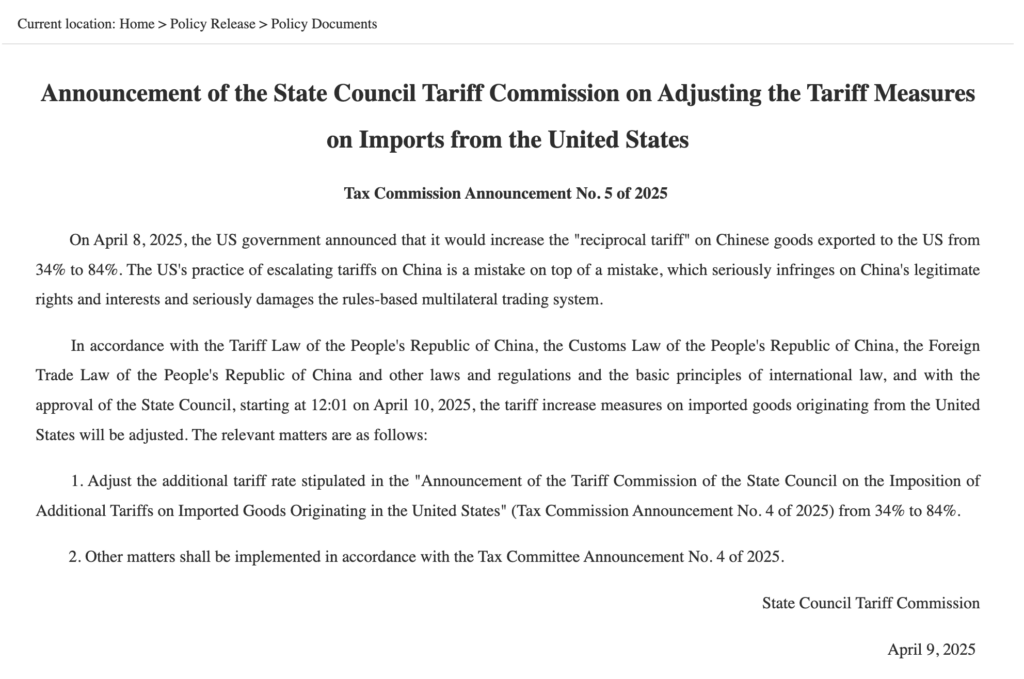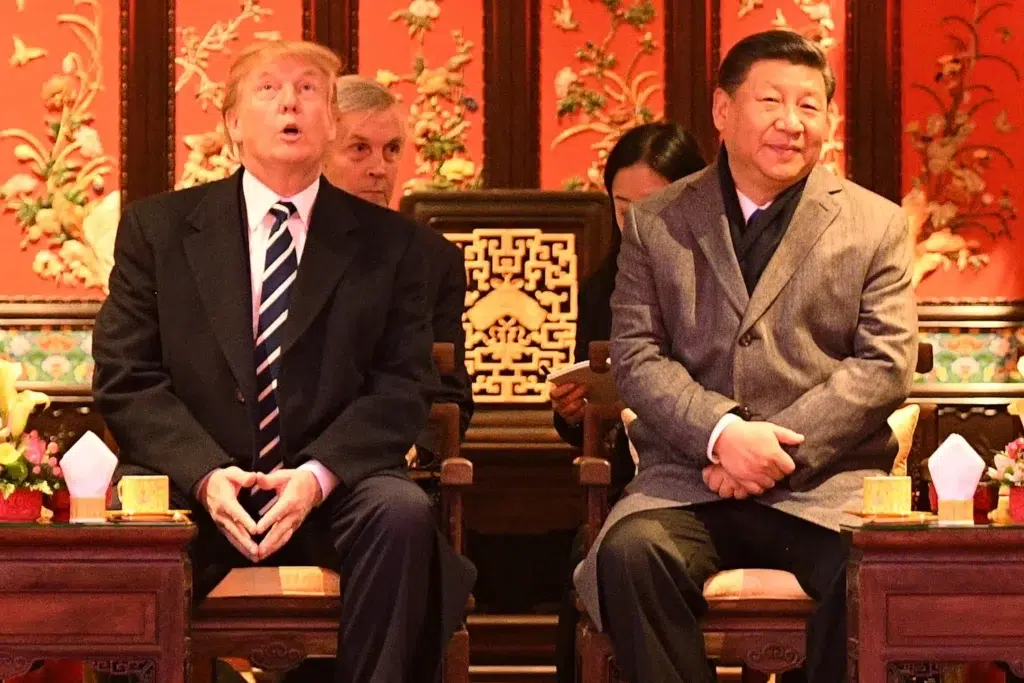China announced Wednesday it would raise tariffs on American goods to 84% starting Thursday, vowing to “fight to the end” in the escalating trade war with the United States. This bold move comes directly after US President Donald Trump increased total tariffs on Chinese imports to 104%.
Beijing didn’t stop at tariffs. The Chinese government launched additional legal action against the US at the World Trade Organisation and imposed new restrictions on American companies doing business with Chinese firms.

“If the US insists on further escalating its economic and trade restrictions, China has the firm will and abundant means to take necessary countermeasures and fight to the end,” declared the Ministry of Commerce in a statement introducing its white paper on US-China trade relations.
Negotiations at a Standstill
Unlike many other countries that have begun talks with the White House, China has remained silent on whether negotiations are forthcoming. The sequence of retaliatory measures began last Friday when China announced a 34% tariff on all US imports, along with export controls on rare earth minerals following Trump’s “Liberation Day” tariffs.
Trump responded by adding another 50% tariff on Chinese goods and declared negotiations terminated. Wednesday’s newest Chinese countermeasures include adding 11 American companies to an “unreliable entities” list, effectively preventing Chinese businesses from selling dual-use goods to these companies. American Photonics and SYNEXXUS, both military contractors, are among those targeted.
Foreign Ministry spokesman Lin Jian made China’s position clear: “If the US truly wants to resolve issues through dialogue and negotiation, it should adopt an attitude of equality, respect and mutual benefit.”
Phase 1 Deal Disputes
China’s white paper claims the US failed to honor commitments made in the Phase 1 trade deal from Trump’s first term. It specifically points to the US law threatening to ban TikTok unless its Chinese parent company sells it, arguing this violates a mutual agreement not to “pressure the other party to transfer technology to its own individuals.”

Trump recently signed an order extending TikTok’s operation for 75 days after ByteDance representatives contacted the White House indicating China would not approve any sale until trade and tariff negotiations occurred.
Trade Balance Perspective
The Chinese paper argues that when accounting for trade in services and US companies’ operations in China, economic exchange between the two nations is “roughly in balance.” It notes China had a trade in services deficit with the US of $26.57 billion in 2023 across industries like insurance, banking, and accounting.
Trump’s tariffs were designed to address trade deficits, but these calculations typically only considered physical goods, not services.
“History and facts have proven that the United States’ increase in tariffs will not solve its own problems,” the commerce ministry stated. “Instead, it will trigger sharp fluctuations in financial markets, push up US inflation pressure, weaken the US industrial base and increase the risk of a US economic recession.”
Global Response and Market Impact
The European Union joined China in announcing new trade barriers against US goods on Wednesday. The EU will impose 25% tariffs on various US imports as an initial countermeasure to Trump’s duties of 20% on most European products and higher tariffs on automobiles and steel.
Canada’s countermeasures also took effect Wednesday, with targeted US duties hitting dozens of other countries from Japan to Madagascar. Worldwide tariffs have dramatically shifted the global trading landscape, with US market tariffs now averaging above 20%, up from 2.5% before Trump took office.
JPMorgan Chase CEO Jamie Dimon warned that Trump’s tariffs would likely trigger a recession and borrower defaults.
Financial Markets in Turmoil
Global markets suffered severe losses, with damage extending beyond stock markets that have already seen trillions in equity value disappear over the past week. Oil prices fell to four-year lows while investors sold off US Treasury bonds and dollars – typically considered safe-haven assets. Corporate funding markets also showed strain, increasing borrowing costs even for low-risk companies.
Japan and Canada have announced plans to cooperate on stabilizing the global financial system – a role typically filled by the United States during financial crises.
Trump’s Response and Strategy
Trump has dismissed market concerns, offering mixed messages about whether tariffs are permanent while claiming they’re already bringing other leaders to the negotiating table.
“BE COOL! Everything is going to work out well. The USA will be bigger and better than ever before!” he posted on social media.
The president maintains these tariffs will help rebuild America’s industrial base after decades of trade liberalization. His administration indicates a willingness to negotiate with individual countries, potentially addressing foreign aid, military support, and trade barriers together.
Trump has already spoken with leaders from Japan and South Korea, with a Vietnamese delegation scheduled to meet US officials. “These countries are calling us up, kissing my ass,” Trump remarked Tuesday.
Future Tariff Plans
Administration officials suggest these tariffs may remain in place for some time, with additional measures possible. Trump recently reiterated plans for a “major” tariff on pharmaceutical imports, causing pharmaceutical stocks to plummet worldwide.
US officials have stated they won’t prioritise discussions with China, which has warned it has the “determination and means” to continue the fight if Trump continues targeting Chinese goods.
Beyond tariffs, Beijing has imposed restrictions on 18 US companies, primarily in defense-related industries, adding to around 60 American firms already facing penalties over Trump’s tariffs.
Economic and Political Impact at Home
While US stock indexes showed slight recovery Wednesday as investors purchased discounted tech stocks, the S&P 500 has experienced its deepest loss since the benchmark’s creation in the 1950s since Trump announced his tariffs on April 2.
Economists predict these tariffs could increase costs for average US households by several thousand dollars annually – potentially becoming a political liability for a president who campaigned on reducing living costs. A Reuters/Ipsos poll found three out of four Americans expect prices to increase due to the tariffs.
Some companies have already announced immediate price increases, though others may take longer as the tariffs don’t apply to goods currently in transit. Retail giant Walmart, America’s largest importer of containerised goods, maintained its full-year sales forecast and promised to keep prices stable.
Opposition Democrats have struggled to present a unified response, with some criticising the tariffs as counterproductive while others argue Trump’s approach is simply too extreme.
Michigan Governor Gretchen Whitmer summarised this middle position: “Tariffs need to be used like a scalpel, not a hammer.”
